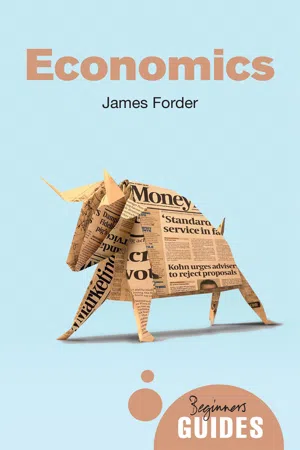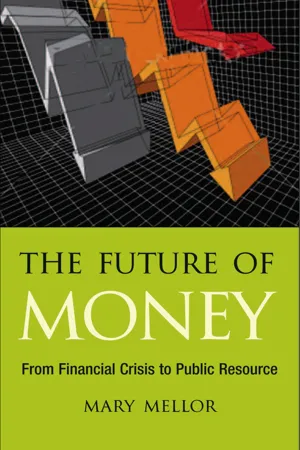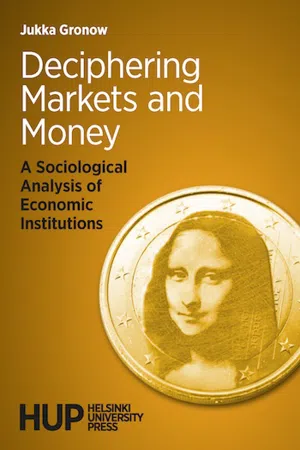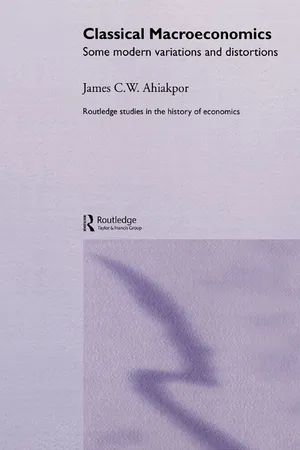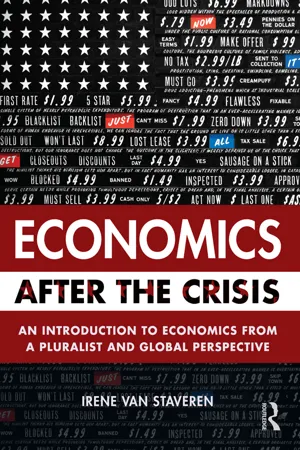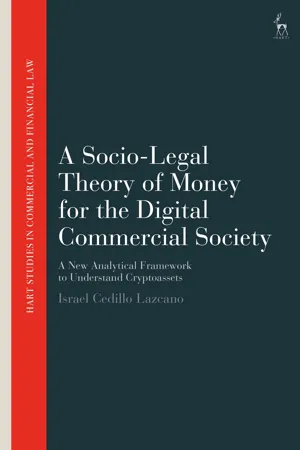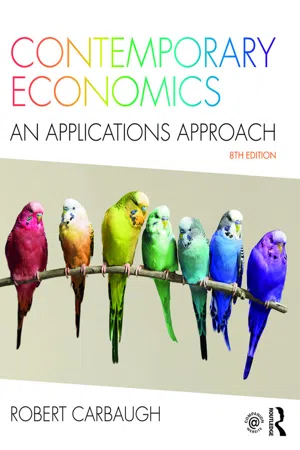Economics
Money
Money is a medium of exchange, unit of account, and store of value widely accepted in transactions. It can be in the form of coins, banknotes, or digital currency. In economics, money facilitates trade, enables specialization, and serves as a measure of value for goods and services.
Written by Perlego with AI-assistance
Related key terms
10 Key excerpts on "Money"
- eBook - ePub
Economics
A Beginner's Guide
- James Forder(Author)
- 2016(Publication Date)
- Oneworld Publications(Publisher)
5 Money and banksSomething that might seem peculiar about the discussion so far is that there has hardly been a mention of Money. It appears as a way of measuring prices, and perhaps as something that people like to make, but apparently not as an essential component of economics at all. Part of the explanation is that – as we shall see – although Money is obviously an important aspect of the functioning of modern economies, there are large parts of economic analysis where it is not nearly so important as might be supposed. It does nevertheless raise some issues of its own – issues concerning the nature of Money itself; what makes something ‘Money’ rather than not Money; where is it that Money comes from; how it is related to economic activity; and what kind of policy actions might be called for, and when?Definition of MoneyDefining Money is a surprisingly difficult task. The first point, though, is that in ordinary English the word ‘Money’ is certainly used more broadly than it is in economics. As I have just said, ‘Money’ is sometimes treated as the thing that some people like to make. But that is not an economist’s usage. Really, what those people are seeking is wealth, or perhaps income. Similarly, we might say ‘Mr Gatsby has a great deal of Money’ – but it would be unlikely to mean that his wallet was at that moment particularly full.Confusion is taken further when economics textbooks provide a list of the functions of Money. It functions, they say, as a unit of account, a medium of exchange, and as a store of value. ‘Unit of account’ means the measuring rod of economic value – the units in which prices are quoted. A ‘medium of exchange’ (or ‘transactions medium’) is the device commonly used to make payments, and a ‘store of value’ is a way of taking the power to make purchases that we have today, and moving that power to purchase into the future. But those are the functions of Money – they are what Money does. They do not exactly tell us what Money is - eBook - ePub
The Future of Money
From Financial Crisis to Public Resource
- Mary Mellor(Author)
- 2010(Publication Date)
- Pluto Press(Publisher)
1 WHAT IS Money?This is not a straightforward question. Money in its long history has been represented by many different things from precious metals, shells and beads to heavy, largely unmoveable stones. It has been made of substances that have value in themselves such as precious metals or represented by something that has no value in itself such as base metal coin or paper. Its operation has been represented in many ways from cuneiform tablets and tally sticks, to paper or electronic records. Conventional economics sees Money as having a number of functions. It is a measure of value (a unit of account), a medium of exchange, a way of making deferred payments and a store of value. Money is seen as evolving with the market system. Barter is often assumed to be the original form of economic exchange with Money emerging to solve the problem of finding suitable mutual exchanges. From this perspective, Money is the product of pre-existing economic exchange.The chosen commodity needed to be valuable, durable, divisible and portable. Precious metals such as gold and silver were obvious choices. As a result, gold has been particularly resonant for modern conceptions of Money. Gold is seen as having an inherent or intrinsic value and was adopted as a basis for Money value until comparatively recently. From this ‘metallist’ perspective, the value of Money still relates back to gold or some commodity that has intrinsic value although, in practice, Money can be represented in many forms, such as base metal coin, paper or electronic record. This view of Money leads to the assumption that Money can only function effectively if it is scarce and valuable. Douthwaite argues that this view, based on the historical scarcity of gold and silver, has distorted economic theory ever since. It has led to the false idea that Money can only be based on a scarce, and therefore valued, resource (1999:33). - eBook - ePub
- Shahzavar Karimzadi(Author)
- 2012(Publication Date)
- Routledge(Publisher)
7 Money originated from its functionsIntroductionIt is a customary convention of almost every economics textbook to open the subject of Money by examining its essential definition. The definition most certainly revolves around one or a mixture of the functions of Money. The function that cannot escape almost any definition of Money is the medium of exchange. This function is inseparable from the theory of the origin of Money regardless of whatever definition is being used. When combined with other functions, it can either be the dominant or the subordinate function. That is typically specified either explicitly or implicitly depending on the author’s preference as to the overriding function.Money is a contingent factual entity. It is a social and economic necessity that emerged with specific social and economic conditions. Its necessity discerns no universal law. In view of this reality then one cannot come up with a universal definition of Money. The very term “define” presupposes the predicate of universality. A definition of Money which can be applied everywhere and all the time is doomed to failure. Moreover, the definition of Money that is not constructed from its functions would be no more than a verbal contortion. It remains in concepts that are empty of content. This is why economists either knowingly or subconsciously define Money in the context of what Money actually does rather than what Money actually is. The definition of Money then is presented as a description of its functions. Relying on the description of the functions of Money leaves room for greater flexibility in case of changing economic environment and the formation of new forms of Money.Defining Money from its functions liberates it from its abstract form. It is much easier to describe what a form of Money does rather than to give an abstract definition of it. An abstract definition that is used in all possible worlds would not last long. The possible worlds are not the same and keep changing. The four functions of Money that are more or less commonly acknowledged in textbooks are the functions of Money as a unit of account, a medium of exchange, a store of value and as a standard for deferred payments. The origin of Money is linked to one or combination of these functions. Chapter 7 - eBook - ePub
Deciphering Markets and Money
A Sociological Analysis of Economic Institutions
- Jukka Gronow(Author)
- 2020(Publication Date)
- Helsinki University Press(Publisher)
It is a medium of exchange, a store of value, and a unit of account. If ‘Money is what Money does,’ one could well argue that in order for something to deserve to be called Money it has to fulfill all three functions. 2 The standard economic theory of Money concentrates on one of the functions: Money as a means of exchange. In these theories, Money comes into being as an unintended consequence of the economic rational reasoning of the individuals. 3 As Smith believed, in order to maximize their barter options, astute traders will hold in stock some of the most regularly exchanged commodities that they expect others will accept in the future in exchange for the goods they possess. Consequently, one of these, more or less gradually, and as if by chance, emerges from among all the myriad options on offer as the general media of exchange, mainly because of its advantageous material properties, such as durability, divisibility, and portability. In various historical periods, different kinds of valuables have acted as means of exchange, for instance, furs in the Novgorod Russia’s fur trade with Western Europe or huge stone rings in ancient Polynesia. Finally, a generally accepted coinage emerges, as if crystallized out of all available options, the value of which is based on the extraordinarily high value of precious metals. The general media of exchange, or Money, allows for the natural process of barter trade to develop into more extensive and general exchange of commodities, and finally to a fully fledged market economy. In these mythical genealogies of Money, the traders come to realize that their life would be much more convenient if they could trade with each other using a generally accepted commodity, Money. Money is, in other words, invented and based on a social contract, as if men had in ancient times come together and agreed on the use of some particular commodity as their general means of exchange - eBook - ePub
Paper Money Collapse
The Folly of Elastic Money
- Detlev S. Schlichter(Author)
- 2014(Publication Date)
- Wiley(Publisher)
The skeptical reader may at this point still raise the following objections: First, the case is built on Money’s function as the medium of exchange, but standard economic textbooks also ascribe other functions to Money, such as a store of value or a unit for accounting and monetary calculation. Second, the changes in Money’s purchasing power that result from changes in Money demand could be disruptive, as they may impair Money’s role as a basis for economic calculation. Maybe it is better to adjust the Money supply in response to changes in Money demand than to allow Money’s price to change. This would make sure that Money is a reliable tool for economic calculation. Third, if Money production is not needed, how can we account for the growth in banking, which for a long time has included the issuance of Money substitutes and fiduciary media, the latter meaning uncovered claims to Money proper that are used by the public just like Money, for example, demand deposits. How can we account for the fact that the world has moved away from commodity Money of fixed supply to paper Money of perfectly flexible supply?These are all good and valid questions. We will address each one of them in detail in the course of our investigation. At this juncture it may just be sufficient to make the following points.All additional functions that can be assigned to Money are the result of Money being the accepted medium of exchange. These functions, important as they are, are derivatives of the medium-of-exchange function. Because Money is the medium of exchange and every good or service is traded against Money, Money prices are ideal for economic calculation. As to Money being a vehicle for storing wealth, it is apparent that many other assets can be used for that purpose, too. Many of these have the additional attraction of potentially generating returns over time. Money does not offer any returns. It can therefore compete with other potential storages of wealth only by offering something special, and that is its universal acceptance in exchange for goods and services, its unique marketability, the ability to be exchanged for goods and services faster and more conveniently than any other asset. That, after all, is why it is Money. So we are again back to the medium-of-exchange function of the monetary asset.Certain financial assets, in particular high-quality debt claims that are traded in very liquid markets, can sometimes become “near-monies,” and their owners may thus feel a reduced need to hold Money proper. But these assets are fundamentally different in that they constitute simultaneously somebody else’s liability and therefore always carry an additional risk. Proper commodity Money, such as gold, but also fiat Money in the form of irredeemable paper tickets, is a financial asset that is not somebody else’s liability at the same time. The purchasing power of this Money varies only with changes in the demand for Money and, in the case of paper Money, also with changes in its inherently flexible supply. We see here that the inflexibility of supply in the case of commodity Money makes it a superior store of value. - eBook - ePub
- John Smithin(Author)
- 2008(Publication Date)
- Routledge(Publisher)
In the classical economic sociology literature it was also Weber (1978, 2003) who made the arguments that a Money of account is the prerequisite for rational accounting, the publication of price lists and financial results, and for the calculation of profit and loss generally. This view was also shared by the economist Keynes (1930, 3) who says quite clearly and unequivocally that “[m]oney-of-account … is the primary concept of a theory of Money”. Ingham (2004, 21–3) explains that “Money of account makes possible prices and debt contracts … Money accounting, with or without an actual ‘Money stuff’, is the means by which modern market exchange is made possible … producing action at both spatial and temporal distance”. In other words, for business operations to be conceivable at all there must be some mechanism whereby payments actually can be made, and profits can be realized in some socially objective form, not reducible to subjective private utilities.Money as a unit of account and means of payment
Dow and Smithin (1999), drawing on Hicks (1989), further identify an important element of a monetary economy as the existence of a unique ultimate or final monetary asset in which the twin functions of the unit of account, just discussed, and means of (final) payment are actually combined.4 Contrary to suggestions made in the “new monetary economics” (NME) literature of the 1980s (Fama 1980), these two specific functions are inseparable. The NME literature, though, tended to confuse this issue by talking mainly about the separation of functions at the level of the medium of exchange, again showing the influence of the standard barter exchange theory (Smithin 2003a). This idea of an ultimate monetary asset corresponds to what is known as base Money in mainstream literature or valuata Money - eBook - ePub
- James C.W. Ahiakpor(Author)
- 2003(Publication Date)
- Routledge(Publisher)
He explains that Money is “not only a medium of exchange, but…also…a measure of value. It serves as a means of comparing values of different things by expressing them both in a common denominator” (1912:18; italics in original). Also, “Money is that particular kind of wealth in terms of which the value of all other kinds of wealth is measured” (5; italics in original). A.C.Pigou defines Money in his 1917 restatement of the quantity theory of Money in reaction to Fisher’s 1911 exposition of the equation of exchange alternative as “legal-tender Money,” the value of whose unit, “like the value of everything else,” is determined by the “general conditions of [its] demand and supply” (1917:39, 40), very much in line with Marshall’s definition. In discussing the supply of Money, Pigou refers to “currency” as well as “inconvertible paper notes” issued on the authority of government, and whose “supply curve…is obviously a vertical line fixed in whatever position the government may choose” (53–5). He also describes “bank notes and bank balances against which checks can be drawn” as “titles to legal tender” or “bank Money” (42, 47, 60). Similarly, Pigou (1927) retains the distinction between legal-tender Money (or currency) and bank Money or checkable deposits, although sometimes applying the title Money liberally to both, as in his claim that people hold their store of value “in the form of Money—mainly, of course, bank-Money” (121). Pigou later expands his definition of Money to include other assets that may serve as media of exchange, reflecting elements of Fisher’s definition. Thus, he describes Money as having “two divisions, current Money and bank Money,” where his “current Money” includes Fisher’s “primary” and “fiduciary” monies, namely, “gold coins, token coins and Bank of England notes” (1949:6). But his “bank Money” includes “bank balances… plus overdraft facilities” (ibid.; italics in original) - eBook - ePub
Economics After the Crisis
An Introduction to Economics from a Pluralist and Global Perspective
- Irene van Staveren(Author)
- 2014(Publication Date)
- Routledge(Publisher)
through accounting. The second function of Money is as a unit of exchange. Obviously, this makes economic life much easier. Rather than dragging your home-made lentil soup or naan bread to the next village to exchange it for a new sari, and where you would need to find a seller of saris with an appetite for your soup or naan, you simply sell the food in your own village to whoever wants to buy it. And with the Money earned, you go to your favourite sari seller in the next village and choose your size and colour, even when this sari seller does not like lentil soup. The third function of Money is that it also serves as a store of value. Unlike soup or naan, it does not rot or evaporate as days go by. So, you can keep Money for a long time – in your wallet, under the mattress, or in your bank account. The fourth function of Money is that it enables accumulation in a capitalist economy. This was expressed by Marx as the sequence of Money (M) and commodities (C), which begins and ends with Money: M – C – M′. The beginning of the exchange chain is Money through debt, which an entrepreneur invests. Then there is a process of exchange in commodities. Also the end of the chain is Money, but now through profit for the entrepreneur.When Money depends on trust, it may also lose trust. Monetary institutions are organisations, regulations, and social norms which together guarantee the functioning of a monetary system. When economic agents lose trust in a particular bank, they are afraid that the Money that they have in their checking account and savings account will no longer be accessible to them, because the bank has lent it all out or even lost it. This fear creates a bank run, to make the Money liquid. Liquid Money means that Money is shifted from deposits to immediately accessible forms of Money. The problem, however, is that banks use leverage for the Money they take in on deposits, so that they cannot fulfil the desire for liquidity of all their deposit holders. Leverage - eBook - ePub
A Socio-Legal Theory of Money for the Digital Commercial Society
A New Analytical Framework to Understand Cryptoassets
- Israel Cedillo Lazcano(Author)
- 2024(Publication Date)
- Hart Publishing(Publisher)
3 Legal Analysis of the Concept of MoneyI.IntroductionAs one can infer from the preceding chapters, it is possible to argue that Money is one of the most fascinating institutions in the legal, economic and social history of human civilisation, taking many forms and fulfilling different functions that go beyond the economic descriptions given in most works on the subject. Additionally, it can be incorporated into social, legal and algorithmic codes. The evolutionary dynamics behind these qualitative elements have fostered the emergence of different categories of socioeconomic interactions that have relied in different means of exchange, monies and currencies whose source of liquidity can be found within and outside the market, which often tend to be labelled together under the generic terms ‘Money’ and ‘currency’.Accordingly, this chapter will show how states, in exercise of their ius cudendae monetae, have faced such interactions standardising and stabilising the three traditional monetary functions, independently if we are talking about ‘inside’ and/or ‘outside’ monies. This chapter therefore opens with an analysis of these functions from a legal perspective structured around the constitutional elements introduced by the Peace of Westphalia. It takes as its starting point the function of Money as an ideal and abstract unit of reference defined under a nominalist approach in laws, such as the Coinage Act of the United States,1 the Monetary Law of the United Mexican States2 and the Currency Act 19823 of the United Kingdom, among others, whose interactions tend to foster phenomena, such as currency wars by which states aim to secure an economic advantage following the Wallersteinian trends described chapter two .4 - No longer available |Learn more
Contemporary Economics
An Applications Approach
- Robert Carbaugh(Author)
- 2016(Publication Date)
- Routledge(Publisher)
If you ask your friends “What backs our Money supply?” you may get answers such as “Gold or silver backs our Money.” No! Gold and silver were removed from our monetary system decades ago. We must look elsewhere to see what backs our Money supply.Recall that the major components of our Money supply—paper currency and checking deposits—are promises to pay, or debts. Paper currency is the circulating debt of the Federal Reserve System, and checking deposits represent the debt of depository institutions. These items have no intrinsic value. A $20 bill is simply a piece of paper; a checking account is an accounting entry; and a 25-cent piece has less value as metal than its face value.What underlies the value of a $10 bill or a $500 balance in a checking account? Currency and checking accounts are considered Money because we widely accept them in return for goods and services. We accept Money in exchange because we are confident that others will be willing to accept our Money when we spend it. Put simply, Money is anything that we generally accept as a medium of exchange.The law reinforces our confidence in the acceptability of currency. All U.S. currency, including paper Money and coins, is designated as legal tender—that is, the federal government mandates its acceptance in transactions and requires that dollars be used in the payment of taxes. However, this does not mean that a particular type of currency must always be accepted. For example, a convenience store may legally refuse to accept bills in denominations of more than $20, or an automobile dealer may refuse to be paid only in pennies.Although the legal tender pledge reinforces the general acceptability of currency, it does not apply to other types of Money. For example, the government does not mandate that checks be legal tender. Nevertheless, checking accounts are an important component of the basic Money supply. Although checks are a generally accepted medium of exchange, we may legally turn them down as payments for goods and services. Perhaps you have attempted to buy gasoline from an establishment that has a sign next to the cash register saying “No out-of-town checks!”
Index pages curate the most relevant extracts from our library of academic textbooks. They’ve been created using an in-house natural language model (NLM), each adding context and meaning to key research topics.
